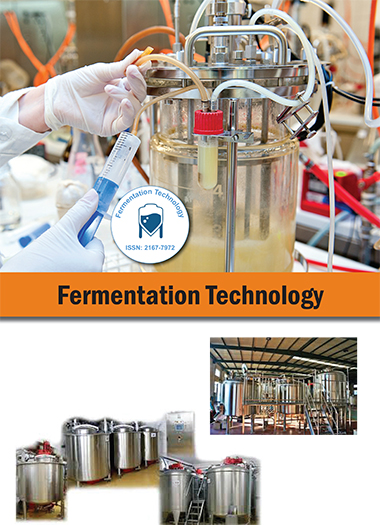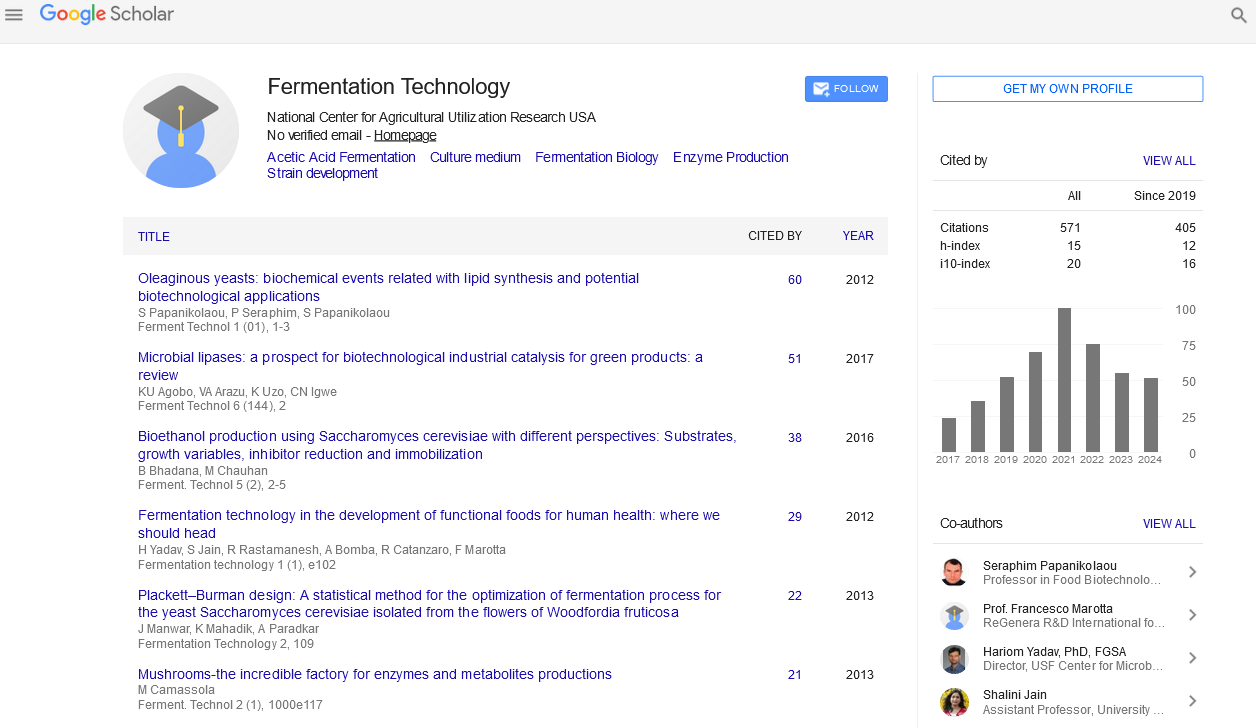Indexed In
- Open J Gate
- Genamics JournalSeek
- Access to Global Online Research in Agriculture (AGORA)
- RefSeek
- Hamdard University
- EBSCO A-Z
- OCLC- WorldCat
- Publons
Useful Links
Share This Page
Journal Flyer

Open Access Journals
- Agri and Aquaculture
- Biochemistry
- Bioinformatics & Systems Biology
- Business & Management
- Chemistry
- Clinical Sciences
- Engineering
- Food & Nutrition
- General Science
- Genetics & Molecular Biology
- Immunology & Microbiology
- Medical Sciences
- Neuroscience & Psychology
- Nursing & Health Care
- Pharmaceutical Sciences
Commentary - (2024) Volume 13, Issue 1
Exploring Solid-State Fermentation: Principles, Applications, and Challenges
Zhi Peng*Received: 26-Feb-2024, Manuscript No. FMT-24-25558; Editor assigned: 28-Feb-2024, Pre QC No. FMT-24-25558 (PQ); Reviewed: 13-Mar-2024, QC No. FMT-24-25558; Revised: 20-Mar-2024, Manuscript No. FMT-24-25558 (R); Published: 27-Mar-2024, DOI: 10.4172/2167-7972.24.13.174
Description
In the search for bioprocessing, Solid-State Fermentation (SSF) stands out as an adaptable and sustainable technique with extensive applications across various industries. Unlike its liquid equivalent, SSF involves the cultivation of microorganisms on solid substrates in the absence or near absence of free water. This unique approach provides unique advantages, including improved product stability, reduced wastewater generation, and the utilization of various raw materials. In this commentary, we explore the complexity of SSF, its principles, applications, and potential outcomes for sustainable bioprocessing.
Principles of solid state fermentation
SSF is the detailed interaction between microorganisms and solid substrates, which serve as both the growth origin and nutrient source. In submerged fermentation, microorganisms are present in a liquid medium, SSF depends on the distribution of nutrients and metabolites through the solid matrix. This diffusion-driven process necessitates careful control of substrate moisture content, pH, temperature, and aeration to optimize microbial growth and product formation. The absence of free water in SSF creates a unique microenvironment that benefits the growth of filamentous fungi, actinomycetes, and certain bacteria, making it particularly suitable for the production of enzymes, organic acids, antibiotics, bioactive compounds, and fermented foods.
Applications across industries
SSF finds applications across a wide spectrum of industries, ranging from food and feed to pharmaceuticals, bioremediation, and biofuel production. In the food industry, SSF is occupied with the production of standard fermented foods such as tempeh, koji, and fermented vegetables, exposing unique flavors, textures, and nutritional profiles. Additionally, SSF is utilized in the production of enzymes, probiotics, and nutraceuticals, providing customized solutions for dietary supplementation and health promotion. In the pharmaceutical sector, SSF serves as a cost-effective and eco-friendly platform for the production of antibiotics, antifungals, and other bioactive compounds, using agricultural byproducts and cellulosic biomass as renewable resources. Furthermore, SSF holds potential for environmental restoration through the degradation of organic pollutants and the production of value-added products from agro-industrial residues, contributing to the circular economy and sustainable development goals.
Challenges and future perspectives
Despite its numerous advantages, SSF is not without challenges. The varying nature of solid substrates exhibits challenges in controlling process parameters and providing uniform microbial growth, leading to variability in product quality and yields. Moreover, the lack of standardized protocols and scale-up strategies prevents the extensive adoption of SSF in industrial settings. Managing these challenges requires interdisciplinary research efforts, including microbiology, bioprocess engineering, materials science, and bioinformatics. Integration of advanced analytical techniques, such as omics technologies and projection modeling, holds potential for resolving the complex interactions between microorganisms and solid substrates, allowing for rational design and optimization of SSF processes. Furthermore, collaboration between academia, industry, and regulatory agencies is essential for establishing guidelines, standards, and best practices to ensure the safety, efficacy, and sustainability of SSF-based bioprocesses.
In conclusion, solid-state fermentation represents a change of opinion in bioprocessing, providing a sustainable alternative to conventional liquid fermentation methods. Its adaptability, eco-friendliness, and ability to verify low-cost substrates make it an effective choice for a wide range of applications, from food and feed production to pharmaceuticals and bioremediation. As we start on the drive towards a more sustainable future, SSF shows as an effective resource for controlling the potential of microorganisms to meet the growing demands for bio-based products and solutions. Through collaborative research, technological innovation, and knowledge sharing, we can resolve the full potential of SSF and prepare for a more sustainable and strong biobased economy.
Citation: Peng Z (2024) Exploring Solid-State Fermentation: Principles, Applications, and Challenges. Ferment Technol. 13:174.
Copyright: © 2024 Peng Z. This is an open-access article distributed under the terms of the Creative Commons Attribution License, which permits unrestricted use, distribution, and reproduction in any medium, provided the original author and source are credited.

